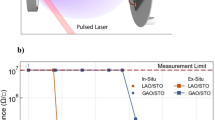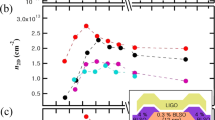Abstract
The discovery of a two-dimensional electron gas (2DEG) at the LaAlO3/SrTiO3 interface1 has resulted in the observation of many properties2,3,4,5 not present in conventional semiconductor heterostructures, and so become a focal point for device applications6,7,8. Its counterpart, the two-dimensional hole gas (2DHG), is expected to complement the 2DEG. However, although the 2DEG has been widely observed9, the 2DHG has proved elusive. Herein we demonstrate a highly mobile 2DHG in epitaxially grown SrTiO3/LaAlO3/SrTiO3 heterostructures. Using electrical transport measurements and in-line electron holography, we provide direct evidence of a 2DHG that coexists with a 2DEG at complementary heterointerfaces in the same structure. First-principles calculations, coherent Bragg rod analysis and depth-resolved cathodoluminescence spectroscopy consistently support our finding that to eliminate ionic point defects is key to realizing a 2DHG. The coexistence of a 2DEG and a 2DHG in a single oxide heterostructure provides a platform for the exciting physics of confined electron–hole systems and for developing applications.
This is a preview of subscription content, access via your institution
Access options
Access Nature and 54 other Nature Portfolio journals
Get Nature+, our best-value online-access subscription
$29.99 / 30 days
cancel any time
Subscribe to this journal
Receive 12 print issues and online access
$259.00 per year
only $21.58 per issue
Buy this article
- Purchase on Springer Link
- Instant access to full article PDF
Prices may be subject to local taxes which are calculated during checkout




Similar content being viewed by others
References
Ohtomo, A. & Hwang, H. Y. A high-mobility electron gas at the LaAlO3/SrTiO3 heterointerface. Nature 427, 423–426 (2004).
Thiel, S., Hammerl, G., Schmehl, A., Schneider, C. W. & Mannhart, J. Tunable quasi-two-dimensional electron gases in oxide heterostructures. Science 313, 1942–1945 (2006).
Brinkman, A. et al. Magnetic effects at the interface between non-magnetic oxides. Nat. Mater. 6, 493–496 (2007).
Reyren, N. et al. Superconducting interfaces between insulating oxides. Science 317, 1196–1199 (2007).
Caviglia, A. D. et al. Electric field control of the LaAlO3/SrTiO3 interface ground state. Nature 456, 624–627 (2008).
Mannhart, J. & Schlom, D. G. Oxide interfaces—an opportunity for electronics. Science 327, 1607–1611 (2010).
Cheng, G. L. et al. Sketched oxide single-electron transistor. Nat. Nanotech. 6, 343–347 (2011).
Lesne, E. et al. Highly efficient and tunable spin-to-charge conversion through Rashba coupling at oxide interfaces. Nat. Mater. 15, 1261–1266 (2016).
Mannhart, J., Blank, D. H. A., Hwang, H. Y., Millis, A. J. & Triscone, J. M. Two-dimensional electron gases at oxide interfaces. MRS Bull. 33, 1027–1034 (2008).
Nakagawa, N., Hwang, H. Y. & Muller, D. A. Why some interfaces cannot be sharp. Nat. Mater. 5, 204–209 (2006).
Huijben, M. et al. Electronically coupled complementary interfaces between perovskite band insulators. Nat. Mater. 5, 556–560 (2006).
Herranz, G. et al. High mobility in LaAlO3/SrTiO3 heterostructures: origin, dimensionality, and perspectives. Phys. Rev. Lett. 98, 216803 (2007).
Hwang, H. Y. et al. Emergent phenomena at oxide interfaces. Nat. Mater. 11, 103–113 (2012).
Chen, Y. Z. et al. Extreme mobility enhancement of two-dimensional electron gases at oxide interfaces by charge-transfer-induced modulation doping. Nat. Mater. 14, 801–806 (2015).
Pentcheva, R. & Pickett, W. E. Charge localization or itineracy at LaAlO3/SrTiO3 interfaces: hole polarons, oxygen vacancies, and mobile electrons. Phys. Rev. B 74, 035112 (2006).
Park, M. S., Rhim, S. H. & Freeman, A. J. Charge compensation and mixed valency in LaAlO3/SrTiO3 heterointerfaces studied by the FLAPW method. Phys. Rev. B 74, 205416 (2006).
Pentcheva, R. et al. Parallel electron–hole bilayer conductivity from electronic interface reconstruction. Phys. Rev. Lett. 104, 166804 (2010).
Huijben, M. et al. Local probing of coupled interfaces between two-dimensional electron and hole gases in oxide heterostructures by variable-temperature scanning tunneling spectroscopy. Phys. Rev. B 86, 035140 (2012).
Zhong, Z. C., Xu, P. X. & Kelly, P. J. Polarity-induced oxygen vacancies at LaAlO3/SrTiO3 interfaces. Phys. Rev. B 82, 165127 (2010).
Rubano, A. et al. Influence of atomic termination on the LaAlO3/SrTiO3 interfacial polar rearrangement. Phys. Rev. B 88, 035405 (2013).
Cancellieri, C. et al. Polaronic metal state at the LaAlO3/SrTiO3 interface. Nat. Commun. 7, 10386 (2016).
Luo, W. D., Duan, W. H., Louie, S. G. & Cohen, M. L. Structural and electronic properties of n-doped and p-doped SrTiO3. Phys. Rev. B 70, 214109 (2004).
Himmetoglu, B., Janotti, A., Peelaers, H., Alkauskas, A. & Van de Walle, C. G. First-principles study of the mobility of SrTiO3. Phys. Rev. B 90, 241204 (2014).
Koch, C. T. A flux-preserving non-linear inline holography reconstruction algorithm for partially coherent electrons. Ultramicroscopy 108, 141–150 (2008).
Muller, D. A., Nakagawa, N., Ohtomo, A., Grazul, J. L. & Hwang, H. Y. Atomic-scale imaging of nanoengineered oxygen vacancy profiles in SrTiO3. Nature 430, 657–661 (2004).
Caviglia, A. D. et al. Tunable Rashba spin–orbit interaction at oxide interfaces. Phys. Rev. Lett. 104, 126803 (2010).
Millis, A. J. & Schlom, D. G. Electron–hole liquids in transition-metal oxide heterostructures. Phys. Rev. B 82, 073101 (2010).
Szymanska, M. H. & Littlewood, P. B. Excitonic binding in coupled quantum wells. Phys. Rev. B 67, 193305 (2003).
Tse, W. K. & Das Sarma, S. Coulomb drag and spin drag in the presence of spin–orbit coupling. Phys. Rev. B 75, 045333 (2007).
Eisenstein, J. P. & MacDonald, A. H. Bose–Einstein condensation of excitons in bilayer electron systems. Nature 432, 691–694 (2004).
Bark, C. W. et al. Tailoring a two-dimensional electron gas at the LaAlO3/SrTiO3 (001) interface by epitaxial strain. Proc. Natl Acad. Sci. USA 108, 4720–4724 (2011).
Bi, F. et al. Room-temperature electronically-controlled ferromagnetism at the LaAlO3/SrTiO3 interface. Nat. Commun. 5, 5019 (2014).
Blochl, P. E. Projector augmented-wave method. Phys. Rev. B 50, 17953–17979 (1994).
Kresse, G. & Furthmuller, J. Efficient iterative schemes for ab initio total-energy calculations using a plane-wave basis set. Phys. Rev. B 54, 11169–11186 (1996).
Kresse, G. & Joubert, D. From ultrasoft pseudopotentials to the projector augmented-wave method. Phys. Rev. B 59, 1758–1775 (1999).
Zhou, H. et al. Anomalous expansion of the copper–apical-oxygen distance in superconducting cuprate bilayers. Proc. Natl Acad. Sci. USA 107, 8103–8107 (2010).
Zhou, H., Pindak, R., Clarke, R., Steinberg, D. M. & Yacoby, Y. The limits of ultrahigh-resolution X-ray mapping: estimating uncertainties in thin-film and interface structures determined by phase retrieval methods. J. Phys. D. 45, 195302 (2012).
Koch, C. T. Towards full-resolution inline electron holography. Micron 63, 69–75 (2014).
Janolin, P. E. Strain on ferroelectric thin films. J. Mater. Sci. 44, 5025–5048 (2009).
Zhang, J. et al. Depth-resolved subsurface defects in chemically etched SrTiO3. Appl. Phys. Lett. 94, 092904 (2009).
Brillson, L. J. Applications of depth-resolved cathodoluminescence spectroscopy. J. Phys. D. 45, 183001 (2012).
Asel, T. J. et al. Near-nanoscale-resolved energy band structure of LaNiO3/La2/3Sr1/3MnO3/SrTiO3 heterostructures and their interfaces. J. Vac. Sci. Technol. B 33, 04E103 (2015).
Rutkowski, M. M., McNicholas, K., Zeng, Z. Q., Tuomisto, F. & Brillson, L. J. Optical identification of oxygen vacancy formation at SrTiO3–(Ba,Sr)TiO3 heterostructures. J. Phys. D. 47, 255303 (2014).
Acknowledgements
This work was supported by the National Science Foundation (NSF) under DMREF Grant number DMR-1629270, AFOSR under award number FA9550-15-1-0334 and AOARD under award number FA2386-15-1-4046. Transport measurement at the University of Wisconsin-Madison was supported by the US Department of Energy (DOE), Office of Science, Office of Basic Energy Sciences, under award number DE-FG02-06ER46327. Research at the University of Nebraska-Lincoln was supported by the NSF MRSEC (Grant no. DMR-1420645). T.J.A. and L.J.B. acknowledge support from NSF grant DMR 1305193. Use of the Advanced Photon Source was supported by the US DOE, Office of Science, Office of Basic Energy Sciences, under Contract no. DE-AC02-06CH11357. STEM and in-line electron holography works by S.H.O. were supported by the Creative Materials Discovery Program through the National Research Foundation of Korea (NRF) funded by the Ministry of Science, ICT and Future Planning (NRF-2015M3D1A1070672) and NRF grant funded by the Korea government (NRF-2015R1A2A2A01007904).
Author information
Authors and Affiliations
Contributions
H.L. and C.B.E. conceived the project. C.B.E., M.S.R., E.Y.T., S.H.O. and L.J.B. supervised the experiments. H.L., J.W.L. and C.B.E. fabricated and characterized the thin-film samples. N.C. and M.S.R. carried out the electrical transport measurements. J.L., B.P., J.S. and S.H.O. carried out the STEM and in-line holography measurements. T.J.A. and B.N. performed the DR-CLS measurements. T.R.P. and E.Y.T. performed the theoretical calculations. H.Z. performed the synchrotron diffraction measurements. H.L., N.C., J.L., T.A., T.R.P., H.Z. and C.B.E. prepared the manuscript. C.B.E. directed the overall research.
Corresponding author
Ethics declarations
Competing interests
The authors declare no competing financial interests.
Additional information
Publisher’s note: Springer Nature remains neutral with regard to jurisdictional claims in published maps and institutional affiliations.
Supplementary information
Supplementary Information
Supplementary Information.
Rights and permissions
About this article
Cite this article
Lee, H., Campbell, N., Lee, J. et al. Direct observation of a two-dimensional hole gas at oxide interfaces. Nature Mater 17, 231–236 (2018). https://doi.org/10.1038/s41563-017-0002-4
Received:
Accepted:
Published:
Issue Date:
DOI: https://doi.org/10.1038/s41563-017-0002-4
This article is cited by
-
In-plane charged domain walls with memristive behaviour in a ferroelectric film
Nature (2023)
-
Emergent ferromagnetism and insulator-metal transition in δ-doped ultrathin ruthenates
npj Quantum Materials (2022)
-
Hysteretic temperature dependence of resistance controlled by gate voltage in LaAlO3/SrTiO3 heterointerface electron system
Scientific Reports (2022)
-
Variance-aware weight quantization of multi-level resistive switching devices based on Pt/LaAlO3/SrTiO3 heterostructures
Scientific Reports (2022)
-
Oxygen vacancies in nanostructured hetero-interfacial oxides: a review
Journal of Nanoparticle Research (2022)



